Artillery in Canada: QF 12-pounder 8-cwt Naval Landing Gun
Ordnance QF 12-pounder 8-cwt Naval Landing Gun
The aim of this website is to locate, identify and document every historical piece of artillery preserved in Canada. Many contributors have assisted in the hunt for these guns to provide and update the data found on these web pages. Photos are by the author unless otherwise credited. Any errors found here are by the author, and any additions, corrections or amendments to this list of Guns and Artillery in Canada would be most welcome and may be e-mailed to the author at [email protected].
QF 12-pounder 8-cwt Naval Landing Gun / Naval Field Gun
The QF 12-pounder 8-cwt Naval Landing Gun was carried on ships of the British and Commonwealth navies for use by naval landing parties. Most were made at Elswick Works in the UK ca 1898. These guns were almost entirely restricted to use as naval landing guns by sailors and marines. Its ammunition was separate Quick Firing (QF), which means the projectile and propellant were separate loading, the latter in an ejectable brass cartridge case; this same ammunition was also used by heavier shipboard 12-pounders. Typically, the landing gun appears on a low carriage, with small-diameter spoked wheels. Despite its 8 hundredweight (8-cwt), it had the same length of rifled bore as the rather older 12-pounder 7-cwt. (Nelson Lawry)
Most of the Naval Landing Guns (aka Naval Field Guns), found in Canada appear to have been on early ships of the Royal Canadian Navy, such as HMCS Niobe, HMCS Aurora, HMCS Rainbow and others. There is also a possibility that some of the guns were left behind when the British garrisons left Canada in 1905-06. It would appear that these guns were not taken on strength by the Canadian Army.

(DND Photo, CN-1997)
HMS Charybdis, Canada’s first Naval training ship, was acquired from the Royal Navy by the Dominion of Canada on 26 July 1881, making its home port in Saint John, New Brunswick. She was a 21-gun Pearl-class corvette, launched on 1 July 1859 at the Chatham Dockyard in the UK. She was armed with 20 8-inch (43-cwt) smoothbore muzzle-loading (SBML) guns mounted on broadside trucks, and one 10-inch 68-pounder (95-cwt) SBML pivot-mounted at the bow. She was a full-rigged ship, 200 feet long at her gun deck and was powered by a 2-cylinder single screw propeller and could make 11.2 knots (20.7 km/h) under steam. She does not appear to have been recorded as having QF 12-pounder 8-cwt Naval Landing Guns on board.
She served at several Royal Navy stations and ports, including Vancouver, British Columbia early in 1862. In October 1880, HMS Charybdis was loaned to the Canadian government for service as a training ship. The Governor General stated in a dispatch to the Colonial Secretary that his government "would not be averse to instituting a ship for training purposes if the Imperial Government would provide the ship". Capt. Peter Astle Scott RN, retired, who had made a second career in the Canadian Department of Marine and Fisheries, was sent to England to bring the ship to Canada, which was only possible after repairs had been carried out (at the expense of the Canadian government). As a Dominion government ship under the commander of the fishery fleet, she wore the blue ensign of Canada and the long blue commission pendant. Found unsuitable for training because of costs and crew size, she was returned to the RN in Aug 1882 and towed to Halifax, where she was sold in 1884, and broken up.
At some point in their history, QF 12-pounder 8-cwt Naval Landing Guns were distributed to Sea cadet units across Canada. There may be up to 17 of these guns in Canada, although not all have been verified or located. There may be more and should you have information on the missing guns please send me an e-mail with an update.
In 1901, U.S. naval intelligence learned that Spain was interested in acquiring two protected cruisers then being built in England by Elswick for Brazil, the Amazonas and Almirante Abreu. The USN thereupon upped the ante and acquired them, the pair then becoming New Orleans and Albany, the sole two protected cruisers of its New Orleans class.
The original Elswick Ordnance Company (EOC) armament consisted of six 6-inch QF and four 4.7-inch QF shipboard guns, replaced by the USN during the first decade of the 20th century by ten each 5-inch/50cal BL guns. Among other light ordnance of British origin, the two cruisers were assigned two each QF 12-pounder 8-cwt Naval Landing Guns, also removed during the first decade. The problem posed in all cases was a family of ammunition alien to everything else in the USN, and whose subsequent production was not justified by so few guns, so they were replaced.
New Orleans saw some action in the SAW, with Albany launched far too late. Both protected cruisers were scrapped in 1930. As written previously by Nelson Lawry, three of the four EOC QF 12-pounder 8-cwt Naval Landing Guns survive on the campus of Norwich University in Vermont.

(USN Photo)
New Orleans in 1898, just before proceeding back to the U.S. (note the long trailing homeward-bound pennant).
The QF 12-pounder 8-cwt Naval Landing Gun in Canadian Service
The following data were extracted from the Library and Archives Canada files by Doug Knight.
Early Use. Before the First World War, HMCS Niobe had two QF 12-pounder 8-cwt Naval Landing Guns. They were deployed to defend the cable landing point at Sydney, Nova Scotia, on the outbreak of war. This is also confirmed by HMCS Niobe’s ammunition allocation for training in 1910, which includes 12-pounder 8-cwt ammunition. HMCS Rainbow’s ammunition allocation in 1910 includes an allowance for her QF 12-pounder 8-cwt Naval Landing Gun. HMCS Canada is rumoured to have used the QF 12-pounder 8-cwt Naval Landing Guns in her mountings, because of the lower recoil force. There is no evidence that the post First World War ships (e.g. HMCS Aurora) had a QF 12-pounder 8-cwt Naval Landing Gun on board.
Post Second World War. In the 1950s, the QF 12-pounder 8-cwt Naval Landing Gun was used for saluting, ceremonial and competitions, as well as gunnery familiarization. On 4 March 1955, HMCS Naden had three QF 12-pounder 8-cwt Naval Landing Guns and limber: Gun No. 919 with limber No. 272, Gun No. 2363, with limber No. 161, Gun No. 1732 with limber No. 248.
In March 1955, HMCS Nonsuch shipped a QF 12-pounder 8-cwt Naval Landing Gun to HMCS Discovery. In March 1955, HMCS Tecumseh shipped a 1QF 12-pounder 8-cwt Naval Landing Gun to HMCS Discovery.
On 19 July 1955, the RCN Barracks in Stadacona had two saluting QF 12-pounder 8-cwt Naval Landing Guns and wanted a third gun. On 20 September 1955, the condition of the two guns at Stadacona was evaluated. The guns (No. 1864 and No. 1845), were heavily pitted and corroded.
On 3 October 1955, a summary noted that the RCN was proposing to discontinue the use of the 3-pounder and QF 12-pounder 8-cwt Naval Landing Gun as saluting guns on shipboard and shore respectively and planned to replace them with the army 6-pr 7-cwt anti-tank gun as a saluting gun. This was not well received due to the space the gun would take on a ship.
The summary recommended that HMCS Stadacona and HMCS Naden should retain their QF 12-pounder 8-cwt Naval Landing Guns as saluting guns. To provide spare parts, it was proposed to remove the QF 12-pounder 8-cwt Naval Landing Guns from five field divisions and retain them at five other field divisions. HMCS York, HMCS Star, HMCS Chippewa, HMCS Tecumseh, and HMCS Donnacona would keep their guns. Guns would be removed from HMCS Queen HMCS Charlotte, HMCS Brunswicker, and HMCS Montcalm and sent east. Guns would be removed from HMCS Unicorn and HMCS Cataraqui and sent west.
On 26 February 1956, it was proposed that HMCS Queen Charlotte, HMCS Brunswicker, HMCS Montcalm, HMCS Unicorn and HMCS Cataraqui would return their guns to Dartmouth. Three guns were to be made serviceable and sent to HMCS Cornwallis. The other two were to be cannibalized to support them and the guns at Stadacona. On 13 April 1956, it was confirmed that HMCS York, HMCS Star, HMCS Chippewa, and HMCS Donnacona would keep their guns and limbers. HMCS Queen Charlotte, HMCS Brunswicker, HMCS Montcalm, and HMCS Cataraqui were to return their guns to the Naval Armament Depot, Dartmouth. HMCS Unicorn and HMCS Nonsuch were to return their guns to the Naval Armament Depot, Esquimalt.
On 28 May 1956, it was decided that HMCS Queen would keep its gun, and that HMCS Tecumseh would send its gun and limber to the Armament Depot in Esquimalt. The guns being prepared for HMCS Cornwallis did not need to be in firing condition. There was a requirement for four guns in firing condition in Halifax.
On 11 July 1956, No. 1001 was noted at CNAD Esquimalt. On 18 July 1956, No. 40 was noted at CNAD Dartmouth. On 18 July 1956, No. 1693 and No. 2020 were noted at CNAD Dartmouth. On 8 August 1956, No. 728 (ex-HMCS Tecumseh) was noted at CNAD Esquimalt.
On 15 January 1957, CNAD Dartmouth summarized their situation: They had received: No. 2020 from HMCS Brunswicker, No. 40 from HMCS Montcalm, No. 1693 from HMCS Cataraqui, No. 1845 and No. 1864 from Stadacona. They had or would issue: No. 2020, No. 1845, and No. 1864 to Cornwallis, No. 40 and No. 1693 to Stadacona.
On 30 January 1957, another summary noted that the 12-pounder requirements on the east coast were four guns at Stadacona and three guns at Cornwallis (total - seven). Based on the holdings (see above) there were two guns deficient. This was being made up by shipping one gun from HMCS Queen Charlotte to Halifax. In addition, it was noted that HMCS Naden had six guns and queried if the requirement there could be reduced to four guns, with one being provided to Halifax.
[Although not in the file - the shipment of the HMCS Queen Charlotte gun must have been cancelled, because a later report still records the gun in that location. This is supported by the later shipment of two guns from HMCS Naden to Dartmouth to make up the deficiency.]
Naden reported the serial numbers on hand as No. 728, No. 919, No. 1001, No. 1213, No. 1732 (corrected from error No. 1752), and No. 2623. On 5 March 1957, HMCS Naden was ordered to ship No. 728 and No. 2363 to CNAD Dartmouth. On 22 January 1960, HMCS Star reported that its gun was at RCSCC Lion.
On 22 June 1960, the condition of the guns at the Field Divisions was evaluated: HMCS Queen - fairly good, but it needed a new breech. HMCS Donnacona – excellent. HMCS Queen Charlotte - poor condition and needed overhaul HMCS Chippewa - good (on loan to HMCS Tecumseh). HMCS Star - very good (on loan to RCSCC Lion). This gun was being used extensively. HMCS York - good [The report implies that one gun was going to be shipped to Naden. It had been intended to send the HMCS Star gun, but since it was in regular use, the HMCS Donnacona gun was recommended in lieu.]
1960 Summary. Based on the foregoing, the RCN had seventeen QF 12-pounder 8-cwt Naval Landing Guns in service: HMCS Cornwallis three, No. 2020, No. 1845, and No. 1864, HMCS Stadacona four, No. 40, No. 1693, No. 728, and No. 2363, HMCS Naden four, No. 919, No. 1001, No. 1213, and No. 1732, HMCS Queen one, HMCS Donnacona one, HMCS Queen Charlotte one, HMCS Chippewa/HMCS Tecumseh one, HMCS Star/RCSCC Lion one, HMCS York one, for a total of 17.
Current Status of QF 12-pounder 8-cwt Naval Landing Guns in Canada, based on the “Company of Canadian Artillery Historians” research. The following 12-pounder 8-cwt Naval Field Guns are known to be in service with Canadian Sea Cadet units:
1. British Columbia, Victoria, 5 (British Columbia) Field Artillery Regiment, Royal Canadian Artillery.
QF 12-pounder 8-cwt Naval Landing Gun, weight 8-0-0 (896 lbs), Gun Serial No. 14, 1898, Breech Block Serial No. 1010, 87, dated 1910, Carriage weight 6-1/4-cwt, Admiralty No. 89, 1899, with Limber Serial No. unknown. The breech block on this gun is for a 12-pounder 12-cwt Field Gun. One part is stamped 4623 P, N, broad arrow, QF12PR12CWT, 1917, 2787. With Limber.
2. British Columbia, Victoria, HMCS Malahat.
QF 12-pounder 8-cwt Naval Landing Gun, weight 8-0-0 (896 lbs), Serial No. 1213, 1900, Breech Block Serial No. 2294 stamped out, new number 1213, dated 1910 King Edward VII cypher. Carriage plate: Q,F, 12 Pr. Naval Trg, Made by (TBC) date (TBC), Exd (Examined) at (TBC). Wt Carriage Complete 6 Cwt (TBC). Admiralty No. (TBC), Kings Arrow. With Limber.
The original breechblock of the landing gun at HMCS Malahat has been replaced with a new and likely reworked block. The old serial number on the breechblock has been scratched out and a new serial number, 1213 (in 1910) at Malahat has been stamped on so that the parent gun and block continue to possess the same serial number. Apparently an upgrade was made in the QF breech mechanism a few years later, and new blocks were sent out from Britain. The originals were likely returned to Woolwich or Elswick to be modified in turn and sent to another location. (Nelson Lawry)
3. British Columbia, Comox, HMCS Quadra.
QF 12-pounder 8-cwt Naval Landing Gun, weight 8-0-0 (896 lbs), Serial No. 1001, RGF 1899, Breech Block Serial No. 1001 King Edward VII cypher. Carriage plate: Q.F. 12 Pr. Naval Trg. Made by R.C.D. Woolwich. 1901, Exd (Examined) at Portsmouth 1903, Wt Carriage Complete 6 1/4 Cwt. Admiralty No. 16, Kings Arrow
4. British Columbia, Comox, HMCS Quadra.
QF 12-pounder 8-cwt Naval Landing Gun, weight 8-0-0 (896 lbs), Serial No. 919, RGF 1898, Breech Block Serial No. TBC, Queen Victoria cypher. Carriage plate: Q.F. 12 Pr. Naval Trg. Made by R.C.D. Woolwich. 1903, Exd (Examined) at Portsmouth 1901, Wt Carriage Complete 6 1/4 Cwt. Admiralty No. 243, Kings Arrow. Formerly at Royal Roads Military College.
5. British Columbia, Comox, HMCS Quadra.
QF 12-pounder 8-cwt Naval Landing Gun, weight 8-0-0 (896 lbs), Serial No. 1213, RGF 1900, Breech Block Serial No. 2294 crossed out, new Serial No. 1910, Queen Victoria cypher. Carriage plate: Q.F. 12 Pr. Naval Trg. Made by R.C.D. Woolwich. 1903, Exd (Examined) at Portsmouth 1901, Wt Carriage Complete 6 1/4 Cwt. Admiralty No. 243, Kings Arrow. Formerly at Royal Roads Military College.
6. Alberta, Calgary, HMCS Tecumseh
QF 12-pounder 8-cwt Naval Landing Gun, weight 8-0-0 (896 lbs), Serial No. 1034, previous Serial No. 4532 crossed out, 1899. Breech Block Serial No. (TBC). King Edward VII cypher. Carriage plate: Q.F, 12 Pr. Naval Trg, Made by R.C.D Woolwich, 1899, Exd (Examined) at Portsmouth. Wt Carriage Complete 6 1/4 Cwt. Admiralty No. 94, Kings Arrow. With Limber.
7. Saskatchewan, Saskatoon, HMCS Unicorn.
QF 12-pounder 8-cwt Naval Landing Gun, weight 8-0-0 (896 lbs), Serial No. 1219 dated 1911, previous Serial No. 1856 crossed out. This gun has a breech block for a 12-pounder 12-cwt NLG, (Serial No. 111), 1917. Queen Victoria cypher. Carriage plate: Q,F, 12 Pr. Naval Trg, Made Elswick Works, 1897, Exd (Examined) at Portsmouth, 1897. Wt Carriage Complete 6 3/4 Cwt. Admiralty No. 40, Kings Arrow. With Limber, Serial No. 9936.
8. Manitoba, Winnipeg, HMCS Chippawa.
QF 12-pounder 8-cwt Naval Landing Gun, weight 7-3-10 (878 lbs), Serial No. 189 dated 1896, Queen Victoria cypher. Carriage plate: Q,F, 12 Pr. Naval Trg, Made Elswick Works, 1898, Exd (Examined) at Portsmouth, 1898. Wt Carriage Complete 6 3/4 Cwt. Admiralty No. 71, Kings Arrow. With Limber, Serial No. TBC.
9. Ontario, Hamilton, HMCS Star.
QF 12-pounder 8-cwt Naval Landing Gun, weight weight 8-0-0 (896 lbs), Serial No. 2050 dated 1897. This gun has a breech block for a 12-pounder 12-cwt Gun, Serial No. 2050), 1903. King Edward VII cypher. Carriage plate: Q,F, 12 Pr. Naval Trg, Made by R.C.D Woolwich, 1903, Exd (Examined) at Portsmouth, 1904. Wt Carriage Complete 6 3/4 Cwt. Admiralty No. 274, Kings Arrow. With Limber. This gun has been in use with the Hamilton Sea Cadet Corps for the last 90 years or so.
10. Ontario, Toronto, HMCS York.
QF 12-pounder 8-cwt Naval Landing Gun, weight weight 8-0-0 (896 lbs), Serial No. 1750, 1903. Breech block, Serial No. 4111 (stamped out), 1917. King Edward VII cypher. Carriage plate: Q.F. 12 Pr. Naval Trg, Made at Elswick Works, 1898. Exd (Examined) at Portsmouth, 1898. Wt Carriage Complete 6 1/4 Cwt. Admiralty No. 56, 1898, Kings Arrow. With Limber, Serial No. 9049.
The breech for this gun is for a 12-pounder and a 14-pounder, which was a Maxim Nordenfelt competitor to the 12-pounder. It would therefore appear the breech blocks were interchangeable. The British gunners apparently used the same ammunition for the two guns. Canada may not have used the Maxim, although that needs to be confirmed.
11. Ontario, Ottawa, HMCS Carleton/30th Field Regiment, Uplands.
QF 12-pounder 8-cwt Naval Landing Gun, weight 8-0-0 (896 lbs), Serial No. 52 crossed out, 1903, new Serial No. 1752. Breech Block Serial No. 742 stamped out, 1898, new No. 1752. Queen Victoria cypher. Carriage weight 6-cwt TBC, Admiralty No. TBC. With Limber. This gun is on loan to the 30th Field Regiment at Uplands, from HMCS Carleton.
12. Quebec, Shawinigan, 62 Field Artillery Regiment.
QF 12-pounder 8-cwt Naval Landing Gun, weight 7-3-10 (878 lbs), (Serial No. 1759), 1903, mounted on a wood wheeled carriage (Serial No. 17) with Limber. Previously at Trois-Rivières, HMCS Radisson. This gun may now be with the Military Museum, aka Général Jean-Victor Allard Armoury.
13. Nova Scotia, Cornwallis, HMCS Acadia Sea Cadets.
QF 12-pounder 8-cwt Naval Landing Gun, weight TBC, (Serial No. 22), date 1904, named Edna, mounted on a wood wheeled carriage with limber (Serial No. 277). Used during parades by both HMCS Acadia Sea Cadets and HMCS Cornwallis Sea Cadets at Cornwallis, Nova Scotia. 1 of 2.
14. Nova Scotia, Cornwallis, HMCS Acadia Sea Cadets.
QF 12-pounder 8-cwt Naval Landing Gun, weight TBC, (Serial No. 40), date 1894, mounted on a wood wheeled carriage (Serial No. TBC) with Limber. Used during parades by both HMCS Acadia Sea Cadets and HMCS Cornwallis Sea Cadets at Cornwallis, Nova Scotia. 2 of 2.
British Columbia, Victoria, 5 (British Columbia) Field Artillery Regiment, Royal Canadian Artillery

(Maxwell Toms and Terry Honour Photo)
QF 12-pounder 8-cwt Naval Landing Gun, weight 7-3-10 (878 lbs), Gun Serial No. TBC, Breech Block Serial No. TBC. King Edward VII cypher. Carriage plate: Q,F, 12 Pr. Naval Trg, Made by R.C.D. Woolwich. 1899, Exd (Examined) at Portsmouth 1899, Wt Carriage Complete 6 Cwt. Admiralty No. 89, Kings Arrow.


Carriage plate: Q,F, 12 Pr. Naval Trg, Made by R.C.D. Woolwich. 1899, Exd (Examined) at Portsmouth 1899, Wt Carriage Complete 6 Cwt. Admiralty No. 89, Kings Arrow.



(Maxwell Toms & Terry Honour Photos)







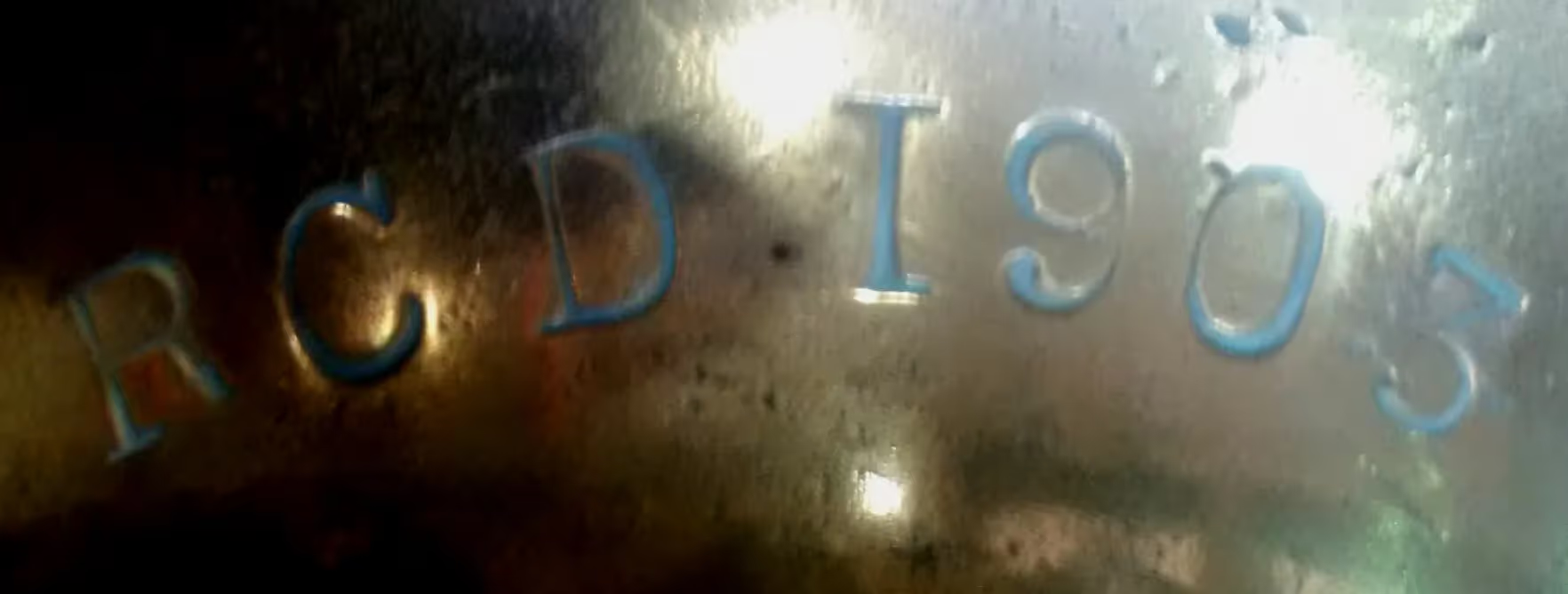
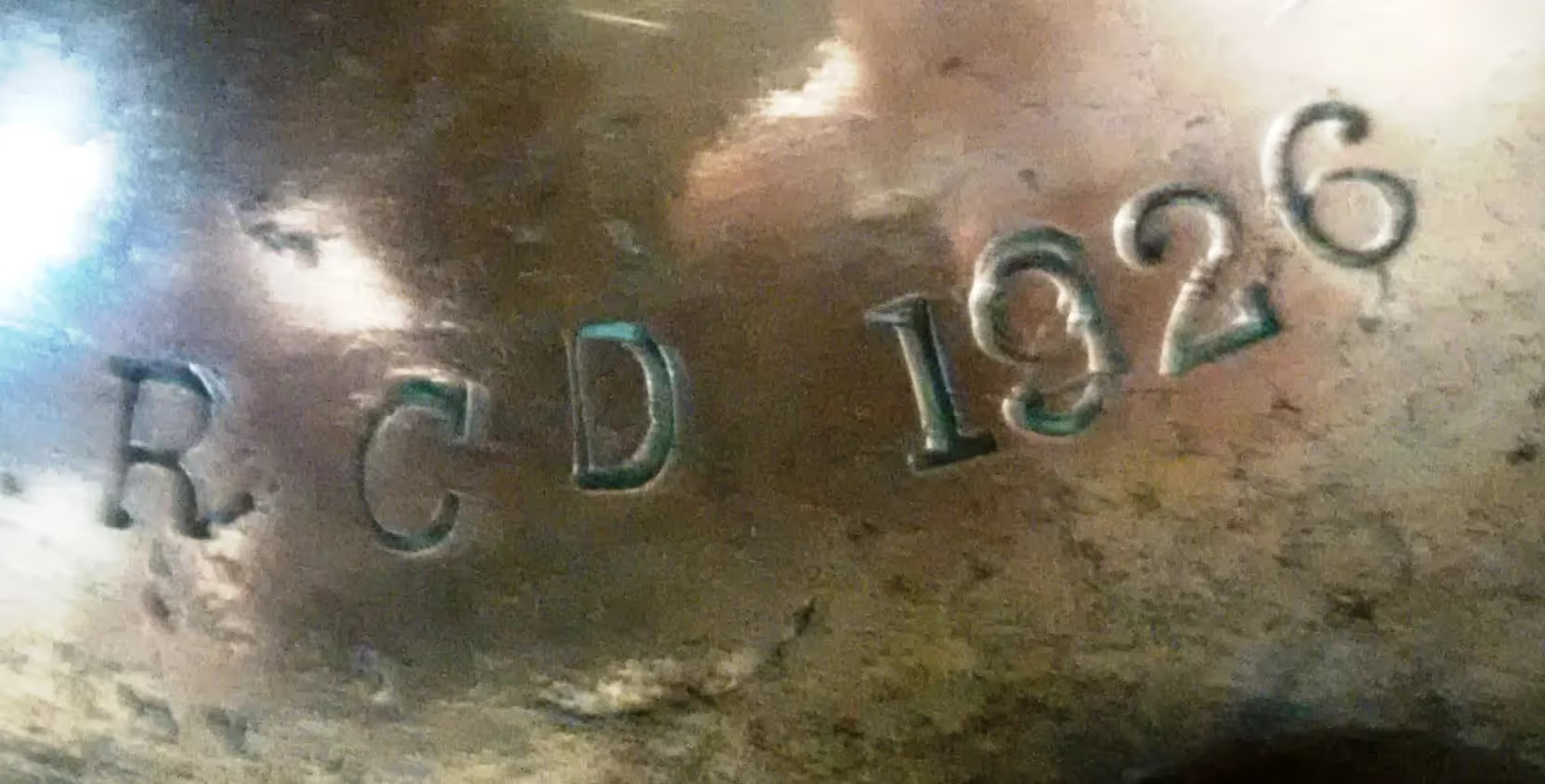

(Al Dadds Photos)
QF 12-pounder 8-cwt Naval Landing Gun, weight 8-0-0 (896 lbs), Gun Serial No. 89, Breech Block Serial No. TBC. King Edward VII cypher. Carriage plate: Q,F, 12 Pr. Naval Trg, Made by R.C.D. Woolwich. 1899, Exd (Examined) at Portsmouth 1899, Wt Carriage Complete 6 Cwt. Admiralty No. 89, Kings Arrow.
British Columbia, Victoria, HMCS Malahat

(Richard Gear Photo)
QF 12-pounder 8-cwt Naval Landing Gun, weight 8-0-0 (896 lbs), Gun Serial No. 1213, 1900, Breech Block Serial No. 2294 crossed out, new Breech Block Serial No. 1213, dated 1910. King Edward VII cypher and Kings Arrow on thebarrel. Carriage plate: Q,F, 12 Pr. Naval Trg, Made by (TBC) date (TBC), Exd (Examined) at (TBC). Wt Carriage Complete 6 Cwt (TBC). Admiralty No. (TBC),
The original breechblock of the landing gun at HMCS Malahat has been replaced with a new and likely reworked block. The old serial number on the breechblock has been scratched out and a new serial number, 1213 (in 1910) at Malahat has been stamped on so that the parent gun and block continue to possess the same serial number. Apparently an upgrade was made in the QF breech mechanism a few years later, and new blocks were sent out from Britain. The originals were likely returned to Woolwich or Elswick to be modified in turn and sent to another location. (Nelson Lawry)




(Richard Gear Photos)
British Columbia, Comox, HMCS Quadra

(Capt Tim Townley, UPAR Photo)
Two of the QF 12-pounder 8-cwt Naval Landing Guns with HMCS Quadra.
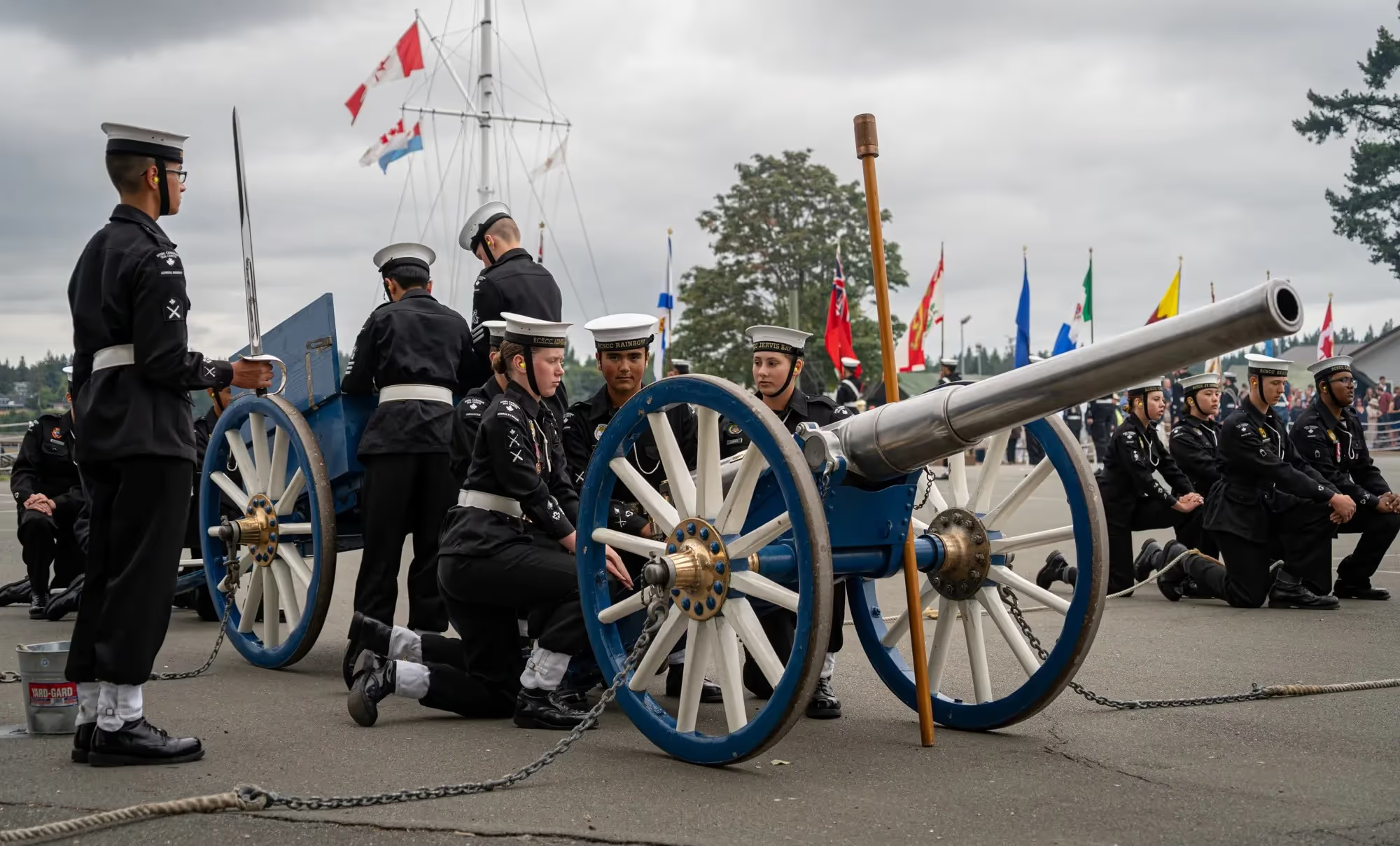
(Capt Tim Townley, UPAR Photo)
QF 12-pounder 8-cwt Naval Landing Gun, HMCS Quadra.

(Capt Tim Townley, UPAR Photo)
A, B and C QF 12-pounder 8-cwt Naval Landing Guns, HMCS Quadra.


(Gene C. Fedderly Photos)
QF 12-pounder 8-cwt Naval Landing Gun, weight 8-0-0 (896 lbs), Serial No. 1001, RGF 1899, Breech Block Serial No. 1001, King Edward VII cypher. Carriage plate: Q.F. 12 Pr. Naval Trg. Made by R.C.D. Woolwich. 1901, Exd (Examined) at Portsmouth 1903, Wt Carriage Complete 6 1/4 Cwt. Admiralty No. 16, Kings Arrow. With Limber.
4. British Columbia, Comox, HMCS Quadra.
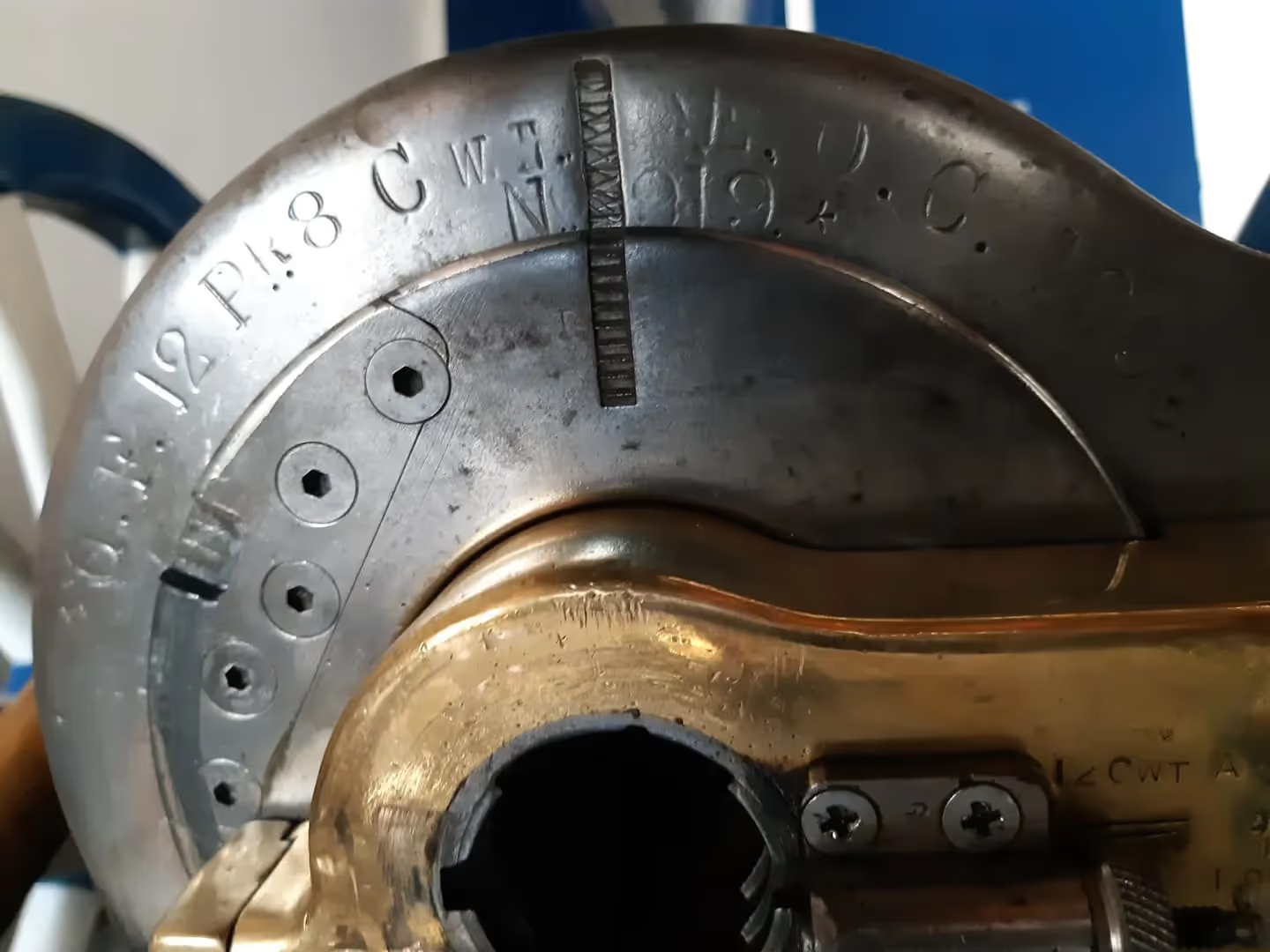
(Gene C. Fedderly Photo)
QF 12-pounder 8-cwt Naval Landing Gun, weight 8-0-0 (896 lbs), Serial No. 919, RGF 1898, Breech Block Serial No. TBC, Queen Victoria cypher. Carriage plate: Q.F. 12 Pr. Naval Trg. Made by R.C.D. Woolwich. 1903, Exd (Examined) at Portsmouth 1901, Wt Carriage Complete 6 1/4 Cwt. Admiralty No. 243, Kings Arrow. Formerly at Royal Roads Military College.
5. British Columbia, Comox, HMCS Quadra.

(Gene C. Fedderly Photo)

(Gene C. Fedderly Photo)
QF 12-pounder 8-cwt Naval Landing Gun, weight 8-0-0 (896 lbs), Serial No. 1213, RGF 1900, Breech Block Serial No. 2294 crossed out, new Serial No. 1910, Queen Victoria cypher. Carriage plate: Q.F. 12 Pr. Naval Trg. Made by R.C.D. Woolwich. 1903, Exd (Examined) at Portsmouth 1901, Wt Carriage Complete 6 1/4 Cwt. Admiralty No. 243, Kings Arrow. Formerly at Royal Roads Military College.
Alberta, Calgary, HMCS Tecumseh

QF 12-pounder 8-cwt Naval Landing Gun, weight 8-0-0 (896 lbs), Gun Serial No. 1034, previous Serial No. 4532 crossed out, 1899. Breech Block Serial No. (TBC). King Edward VII cypher. Carriage plate: Q,F, 12 Pr. Naval Trg, Made by R.C.D Woolwich, 1899, Exd (Examined) at Portsmouth. Wt Carriage Complete 6 1/4 Cwt. Admiralty No. 94, Kings Arrow. With Limber.



(Lucie Alaimo Photos)



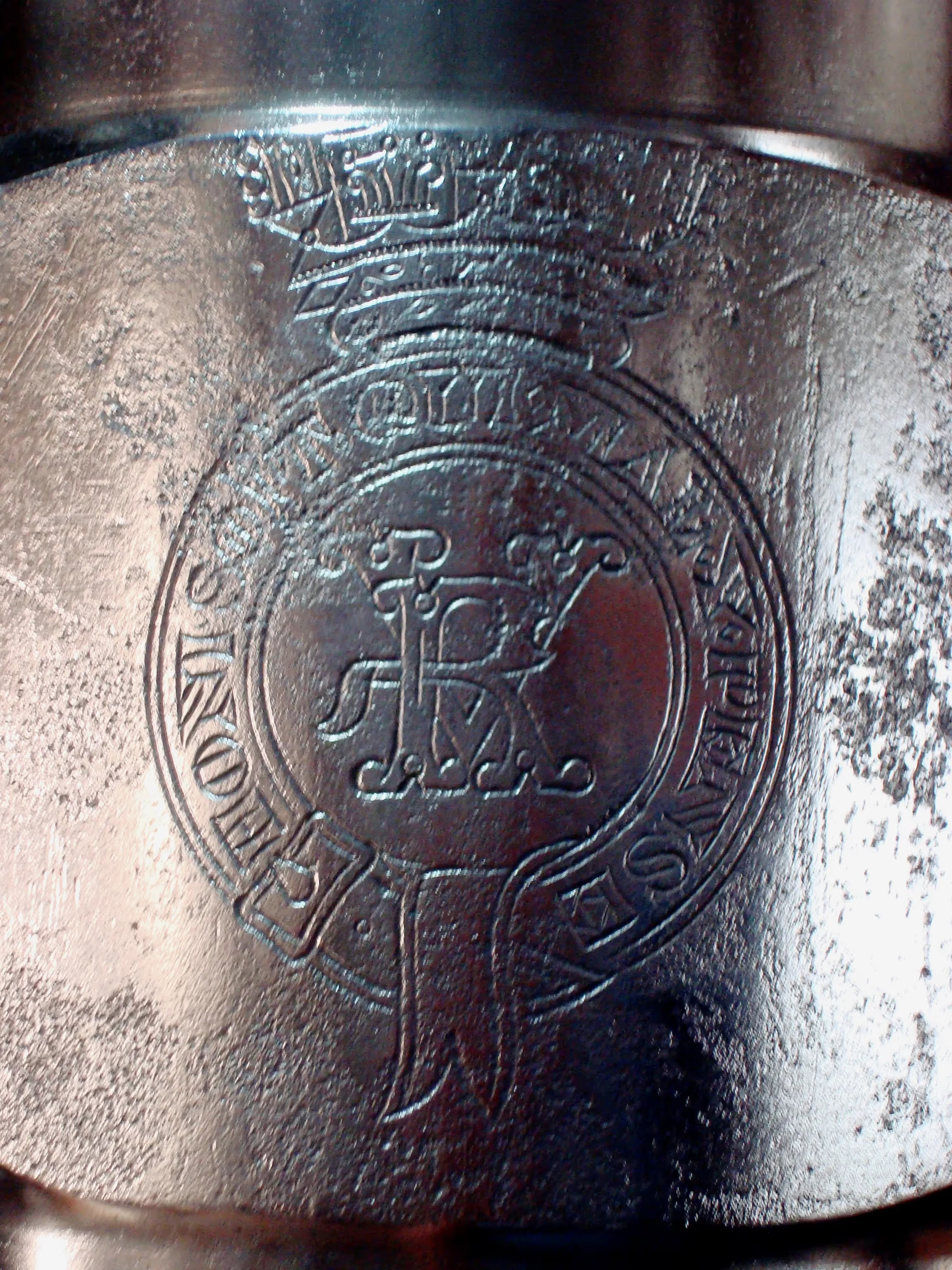
(Lucie Alaimo Photos)

(Kenneth Laing Photos)
QF 12-pounder 8-cwt Naval Landing Gun, weight 8-0-0 (896 lbs), Gun Serial No. 1034, dated 1899, Breech Block Serial No. 4532 stamped out, new No. 1034, dated 1917, Carriage weight 6-cwt, Admiralty No. 94, 1899, with Limber. Queen Victoria cypher. The QF 12-pounder 8-cwt Naval Landing Gun, was carried on ships of the British and Commonwealth navies for use by naval landing parties. This gun has a breech block for a QF 12-pounder 8-cwt Naval Landing Gun, (Serial No. 111), 1917. Several of the photos of the breech screw seem to have “12-pr 12-cwt A & 8-cwt” on them. This suggests that the breech screw was common to the two guns. Both were ship’s guns and this would have simplified spare parts. Apparently an upgrade was made in the QF breech mechanism a few years later, and new blocks were sent out from Britain. The originals were likely returned to Woolwich or Elswick to be modified in turn and sent to another location. (Nelson Lawry).
Saskatoon, HMCS Unicorn, Naval Reserve

(Warren Noble Photo)
QF 12-pounder 8-cwt Naval Landing Gun, weight 8-0-0 (896 lbs), Serial No. 1219 dated 1911, previous Serial No. 1856 crossed out. This gun has a breech block for a 12-pounder 12-cwt NLG, (Serial No. 111), 1917. Queen Victoria cypher. Carriage plate: Q,F, 12 Pr. Naval Trg, Made Elswick Works, 1897, Exd (Examined) at Portsmouth, 1897. Wt Carriage Complete 6 3/4 Cwt. Admiralty No. 40, Kings Arrow. With Limber, Serial No. 9936.



(Warren Noble Photos)
The QF 12-pounder 8-cwt Naval Landing Gun was carried on ships of the British and Commonwealth navies for use by naval landing parties. The original breechblock of the NLG at HMCS Unicorn has been replaced with a new and likely reworked block. The old serial number on the breechblock has been scratched out and a new serial number, 1219 (in 1911), has been stamped on so that the parent gun and block continue to possess the same serial number. Apparently an upgrade was made in the QF breech mechanism a few years later, and a new block was sent out from Britain. The originals were likely returned to Woolwich or Elswick to be modified in turn and sent on to another location. (Nelson Lowry)




(Warren Noble Photos)
QF 12-pounder 8-cwt Naval Landing Gun, weight 8-0-0 (896 lbs), Serial No. 1219. This gun has a breech block for a QF 12-pounder 8-cwt Naval Landing Gun, (Serial No. 111), 1917. King Edward VII cypher. Carriage plate: Q,F, 12 Pr. Naval Trg, Made Elswick Works, 1897, Exd (Examined) at Portsmouth, 1897. Wt Carriage Complete 6 3/4 Cwt. Admiralty No. 40, Kings Arrow. With Limber, Serial No. 9936.



(Warren Noble Photos)
Limber weight 6 & 3/4-cwt, No. 40, 1897, carriage No. 9936 for the QF 12-pounder 8-cwt Naval Landing Gun.
Manitoba, Winnipeg, HMCS Chippawa, Naval Museum of Manitoba

(Lt (N) Simone Smith Photos)
QF 12-pounder 8-cwt Naval Landing Gun, weight 7-3-10 (878 lbs), Serial No. 189 dated 1896, Queen Victoria cypher. Carriage plate: Q,F, 12 Pr. Naval Trg, Made Elswick Works, 1898, Exd (Examined) at Portsmouth, 1898. Wt Carriage Complete 6 3/4 Cwt. Admiralty No. 71, Kings Arrow. With Limber, Serial No. TBC.



QF 12-pounder 8-cwt Naval Landing Gun, weight 7-3-10 (878 lbs), Serial No. 189 dated 1896, Queen Victoria cypher. Carriage plate: Q,F, 12 Pr. Naval Trg, Made Elswick Works, 1898, Exd (Examined) at Portsmouth, 1898. Wt Carriage Complete 6 3/4 Cwt. Admiralty No. 71, Kings Arrow. With Limber, Serial No. TBC.


QF 12-pounder 8-cwt Naval Landing Gun with limber.
(Lt (N) Simone Smith Photos)
Ontario, Hamilton, HMCS Star, Naval Reserve

(HMCS Star Photo)
QF 12-pounder 8-cwt Naval Landing Gun, weight weight 8-0-0 (896 lbs), Serial No. 2050 dated 1897. This gun has a breech block for a 12-pounder 12-cwt Gun, Serial No. 2050), 1903. King Edward VII cypher. Carriage plate: Q,F, 12 Pr. Naval Trg, Made by R.C.D Woolwich, 1903, Exd (Examined) at Portsmouth, 1904. Wt Carriage Complete 6 3/4 Cwt. Admiralty No. 274, Kings Arrow. With Limber. This gun has been in use with the Hamilton Sea Cadet Corps for the last 90 years or so.



(HMCS Star Photos)










(HMCS Star Photos)
QF 12-pounder 8-cwt Naval Landing Gun, HMCS Star.
30th Field, Bytown Gunner’s Firepower Museum

(Maxwell Toms Photo)
QF 12-pounder 8-cwt Naval Landing Gun, weight 8-0-0 (896 lbs), Serial No. 52 crossed out, 1903, new Serial No. 1752. Breech Block Serial No. 742 stamped out, 1898, new No. 1752. Queen Victoria cypher. Carriage weight 6-cwt TBC, Admiralty No. TBC. With Limber. This gun is on loan to the 30th Field Regiment, Uplands, from HMCS Carleton.

(Maxwell Toms Photo)

(Author Photo)

(Author Photo)

(Author Photo)
QF 12-pounder 8-cwt Naval Landing Gun, weight 8-0-0 (896 lbs), Serial No. 52 crossed out, 1903, new Serial No. 1752. Breech Block Serial No. 742 stamped out, 1898, new No. 1752. Queen Victoria cypher. Carriage weight 6-cwt TBC, Admiralty No. TBC. With Limber. This gun is currently stored with 30th Field Regiment, Uplands.
Ontario, Toronto, HMCS York

(HMCS York Photo)
QF 12-pounder 8-cwt Naval Landing Gun, weight weight 8-0-0 (896 lbs), Serial No. 1750, 1903. Breech block, Serial No. 4111 (stamped out), 1917. King Edward VII cypher. Carriage plate: Q.F. 12 Pr. Naval Trg, Made at Elswick Works, 1898. Exd (Examined) at Portsmouth, 1898. Wt Carriage Complete 6 1/4 Cwt. Admiralty No. 56, 1898, Kings Arrow. With Limber, Serial No. 9049.
The breech for this gun is for a 12-pounder and a 14-pounder, which was a Maxim Nordenfelt competitor to the 12-pounder. It would therefore appear the breech blocks were interchangeable. The British gunners apparently used the same ammunition for the two guns. Canada may not have used the Maxim, although that needs to be confirmed.







(HMCS York Photos)
QF 12-pounder 8-cwt Naval Landing Gun, weight weight 8-0-0 (896 lbs), Serial No. 1750, 1903. Breech block, Serial No. 4111, 1917. King Edward VII cypher. Carriage plate: Q,F, 12 Pr. Naval Trg, Made at Elswick Works, 1898. Exd (Examined) at Portsmouth, 1898. Wt Carriage Complete 6 3/4 Cwt. Admiralty No. 56, Kings Arrow. With Limber, Serial No. TBC.
Quebec, Trois-Rivières, HMCS Radisson

(LCol Yvon Begin Photos)

(LCol Yvon Begin Photo)
QF 12-pounder 8-cwt Naval Landing Gun, weight 7-3-10 (878 lbs), Gun Serial No. TBC, Breech Block Serial No. TBC. King Edward VII cypher. Carriage plate: Q,F, 12 Pr. Naval Trg, Made at Elswick Works 1896, Exd (Examined) at Portsmouth 1896, Wt Carriage Complete 6 3/4 Cwt. Admiralty No. 17, Kings Arrow.
This gun is on loan to 62e RAC (62 Field Artillery Regiment), Shawinigan, from HMCS Quebec, (Naval Cadet Unit), Trois-Rivières (Marine).



Q.F 12 Pr. 12 Cwt A & 8 Cwt. E.O.C. 1902, No. 1759 (crossed out).

Q,F, 12 Pr. Naval Trg, Made at Elswick Works 1896, Exd (Examined) at Portsmouth 1896, Wt Carriage Complete 6 3/4 Cwt. Admiralty No. 17, Kings Arrow.

(WO Michel Paprocki Photos)

Weight 7-3-10 (878 lbs), FOR DRILL PURPOSE ONLY on the barrel.

King Edward VII cypher on the barrel.

Q.F. 12 Pr & 14 Pr, E.O.C. 11, 1910, No. 2302 on the trail.

(LCdr Martin Bouchard Photos)
QF 12-pounder 8-cwt Naval Landing Gun, weight 7-3-10 (878 lbs), Gun Serial No. TBC, Breech Block Serial No. TBC. King Edward VII cypher. Carriage plate: Q,F, 12 Pr. Naval Trg, Made at Elswick Works 1896, Exd (Examined) at Portsmouth 1896, Wt Carriage Complete 6 3/4 Cwt. Admiralty No. 17, Kings Arrow.
This gun is on loan to 62e RAC (62 Field Artillery Regiment), Shawinigan, from HMCS Quebec, (Naval Cadet Unit), Trois-Rivières (Marine).




(HMCS Acadia Sea Cadets Photos)
13. Nova Scotia, Cornwallis, HMCS Acadia Sea Cadets.





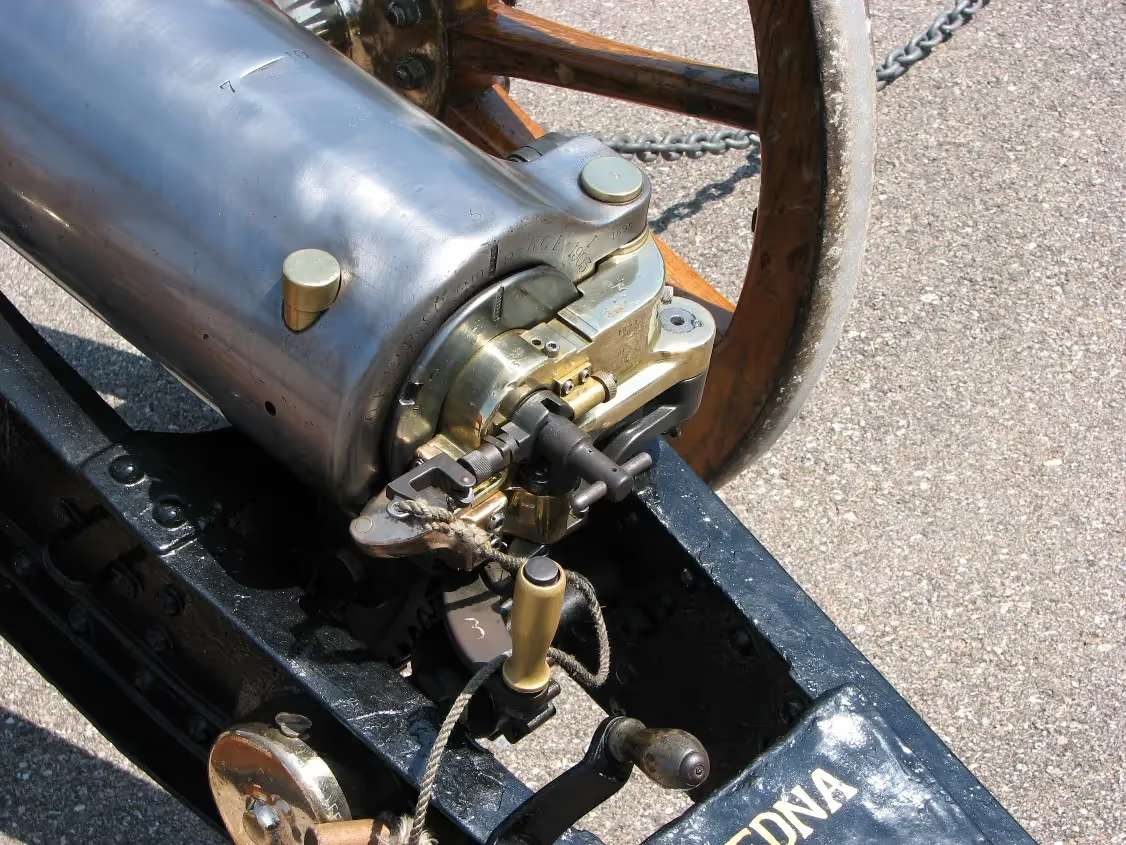
(Grant van Zeumeren Photos)
QF 12-pounder 8-cwt Naval Landing Gun, weight TBC, (Serial No. 22), date 1904, named Edna, mounted on a wood wheeled carriage with limber (Serial No. TBC). Used during parades by both HMCS Acadia Sea Cadets and HMCS Cornwallis Sea Cadets at Cornwallis, Nova Scotia. 1 of 3.
Grant wrote: Edna was manufactured during the reign of Edward VII, 1903 to be specific. I believe her serial number is 1693 as it was marked on the breech end of the gun alongside other technical data. Laura was a much, much earlier gun from Queen Victoria's reign (1894) and may have had a serial number as low as 40 on the gun itself which stands to reason given the date of adoption of the type. Both guns had limbers with somewhat different date codes and I believe the limbers had been mismatched at different points in the past. In fact, when I would go to pick up a gun from the drill shed at Stadacona, the drill instructors would grab whichever gun and limber was closest and wheel that on out. I was horrified on returning a gun at the end of the summer to see how they unloaded them from cube trucks... completing that task with cadets was always a very careful, delicate affair as safety is of paramount concern but the cadets themselves also approached the guns with a great deal of reverence and care. Stadacona did things a bit differently. Their unloading method was essentially wheeling the gun to the ramp off the back of the truck, placing gym mats all around the interior walls nearby and then literally letting a loose cannon roll down the ramp until it ran out of steam somewhere on the drill hall floor or (more likely) turned on hitting pavement and careened into a wall. When I was at that drill shed last, there were large visible drywall patches right around muzzle-height. Whether those were from a less refined process that did not involve gym mats or from occasions in which the guns decided to turn much later than usual is anyone's guess. 277 is a date code from a limber, probably Laura's, but who knows if that is actually the original limber issued with the gun (my guess is probably not). Indeed, I think that it is best to understand the guns, the carriages and limbers to be separate entities-- in a ship, these guns were normally part of its mounted weapons and were dismounted and placed in embarked carriages for use on land (as happened in the Boer War) so I believe it to be likely that the crews would take what was available first rather than rummage through the close confines of the ship's stores for specific, serialized carriages and limbers.
As I am sure you are well aware, the 12lb field gun on 8cwt carriage is the piece used in the Naval Field Gun Run that used to amuse audiences at the Royal Nova Scotia Tattoo and over in Portsmouth in the UK as well. Several of the guns at Stadacona show wear on the underside of the muzzles from where the guns would be lifted by their trails up into the air and balanced on the muzzles to allow the wheels to be removed for the execution of the run; when this evolution is conducted on hard surfaces, it tends to wear that area down flat somewhat. The Gun Run is no longer practiced by the RN itself (a civilian Gun-Run League was organized to maintain the tradition in the UK but I do not know if it persists) and has not been practiced by MARCOM or RCN crews in many years... probably due to its tendency to gruesomely maim participants during training and actual performances. The Sea Cadets I worked with had a healthy respect for the sheer mass of the guns and the sheer power of the saluting charges (we used to place an old white top cap over the muzzle of Edna and fire one of those charges, resulting in bits of fabric being scattered for twenty or thirty feet from the muzzle and the rim rolling around drunkenly on the deck) so happily we had no such instances of injuries while training with the guns. However I did once see a sea gull obliterated when it landed right in front of Edna's muzzle as the guns were firing alternating salvos for a ceremony of the flags in Halifax in the early 2000s. The firing party was laser focused on their tasks and did not register the presence of the visitor, and the gun captain did not see the bird until she realized that the cloud of smoke issuing from the muzzle now included feathers (you might not want to add that one to the website as the destruction of wildlife with artillery often offends though I respectfully submit that for a seagull that is one hell of a send-off).
These guns were made in the thousands over the years-- they were the standard anti-torpedo boat and destroyer gun to be found on many large ships, and the main armament of a great many small ships. I believe your observation about them coming off of early RCN vessels is accurate, and it also makes Laura, with a potential serial number of 40, being significant for being a very early example of what was once an extremely common type.
As I remember more, I will share it. I do have at my parent's place in Nova Scotia a copy of a very old field gun drill manual that Sea Cadets at ACADIA trained from for decades before a much more simplified version came into existence in the late 1990s. If I make it out that way and am able to find it I will try to scan it and send it along as it goes to some pains to explain why the various evolutions are actually necessary.
14. Nova Scotia, Cornwallis, HMCS Acadia Sea Cadets.



(Grant van Zeumeren Photos)
QF 12-pounder 8-cwt Naval Landing Gun, weight 8-0-0 (896 lbs), (Serial No. 40), date 1894, named Laura, mounted on a wood wheeled carriage with Limber (Serial No. 277). Used during parades by both HMCS Acadia Sea Cadets and HMCS Cornwallis Sea Cadets at Cornwallis, Nova Scotia. 2 of 3.
15. Nova Scotia, Halifax, Naval storage, loc unknown.
QF 12-pounder 8-cwt Naval Landing Gun, weight TBC, (Serial No. TBC), date TBC, named Rosie, mounted on a wood wheeled carriage (Serial No. TBC) with Limber. Used during parades by both HMCS Acadia Sea Cadets and HMCS Cornwallis Sea Cadets at Cornwallis, Nova Scotia. 3 of 3.
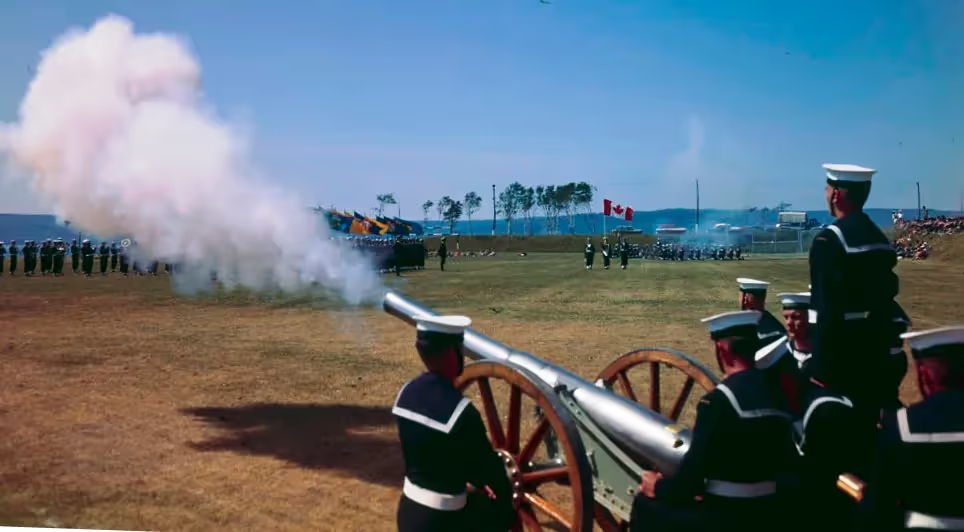
(Library and Archives Canada Photo, MIKAN No. 4821529)
QF 12-pounder 8-cwt Naval Landing Gun, Flag Ceremony, Cornwallis, 1965.





